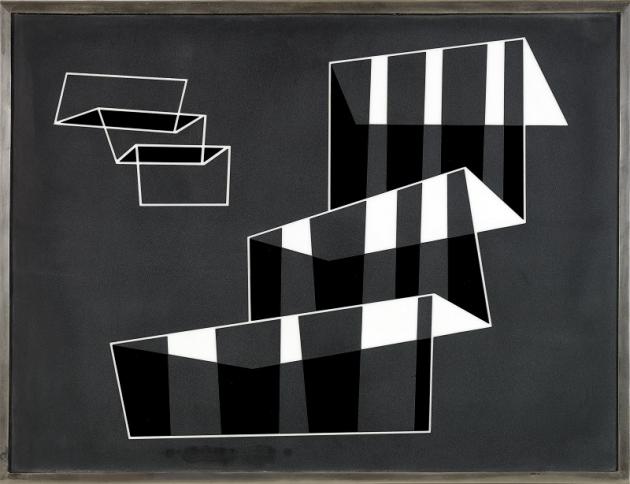This exhibition of Josef Albers focuses solely on the artist’s exploration of black throughout his life, with unexpectedly diverse pieces serving to highlight the vast inventiveness of one artist constrained to a single gradient. Combined with an equally constrained attitude towards composition and scale, the deliberate similarities of many compositional sequences in fact amplify the slightest of tonal variations. A world of difference in mood can be made by the combination of gradients within this single spectrum between black and white, and Albers’ experiments in materials through which to propel black and its tonality sharpen our attentiveness to the close details of their physical qualities. Indeed, following this surprisingly rich and varied show is a tiny room showing sequences in colour, which by comparison look unruly and untamable, with seemingly infinite number of combinations of tonal gradients within the colour spectrum. Where bright colours may instantly appeal, it is the academic exploration of black tonality that becomes most satisfying.
One thanks the order and regular nature of Bauhaus compositional practice to allow this academic exploration to take place; with the ‘Variant/Adobe’ and ‘Homage to the Square’ sequences featuring consistently sized, rectangular canvases filled with only the bare minimum of simple parallel lines, the compositions are so identical and non-intrusive to the surface area as to allow the tonal variances to show with more emphasis, both within and between pieces. Similarities to the working methods of Paul Klée – his contemporary – are clear, being conceived as pieces through which to explore the properties of paint and colour rather than to portray a pre-conceived representational image.
Yet these represent the later – and arguably best known – of Albers’ works. Preceding them are fascinating examples drawn from earlier in his career, amongst which the earliest known extant drawing from 1911, ‘Blick aus meinem Fenster Stadtlohn’. Certainly some exhibitions which choose to select works based on a given theme fail to fully counter the niggling thought in the viewer that pieces are selected for convenience, their significance tenuous (especially if preceding the definitive artistic movement in question). So it is a happy occurrence to find the preponderance on black, tonal quality and a distinct sense of linearity very definitely present in this most early of works. Small and unassuming, it nonetheless shows a very clear and tangible interest in the great variations achievable in greyscale hatching, depicting a silhouetted view of dark buildings in gloom.
Supporting photography similarly adds strength to the study, adding to the tracing of black studies leading up to the more famous sequence of ‘Square’ and ‘Adobe’ works. Again the simplicity and careful, academic methodology is prevalent, with photographs shown next to their inversions; trees sprouting from snow appear again as white strands from an inexplicable black surface. Returning to the themes of linearity and geometric lines bisecting surface area is a photograph of criss-crossing railway tracks with its inversed counterpart.
Included is a sequence of greyscale works using the motif of a treble clef as base design; the catalogue describes these as “important” though for the uninitiated, does not expand why. Far more interesting are nearby pieces from a series of ‘Studies for Graphic Tectonic’. These are gridded paper rather like that used in exercise books (probably is, actually) with a geometric shape drawn in outline repeating itself radiating outwards, placing historically nearby the Op Art movement. While the composition of single lines placed so as to appear vibrating together does belong to this movement, other qualities link it to the exploration of greyscale, or rather, the keen attention to the potential of subtle variances present throughout the show. On close inspection, the lines are drawn in precise ink, being both perfect and imperfect, with variances within each stroke according to the distribution of colour and pressure of the hand. Similarly, the almost identical patterns are drawn onto paper bearing slightly different sized gridding with subtly contrasting moods or tones as a result.
As mentioned, several pieces use a simplicity of composition repeated in different medium, lending contrasting textural finishes to the works, through which the varying properties of black are explored. Albers’ varying pieces entitled ‘Steps’, featuring a geometric impression of steps which in actuality float in space and resemble pattern more than representational hard object, are labelled 1931–56. The long period of completion indicates a closer look at this deceptively simple piece; surely enough in raking light it is visible that a previous painting existed below, perhaps of a similar composition. It is tantalizingly unclear. Elsewhere, the same composition (inexplicably and unhelpfully displayed on a wall obscuring its counterpart, hindering comparison) rendered in sandblasted opaque flashed glass. Black is here applied throughout the base surface, not simply applied superficially, and appears impenetrable, solid and enticing for its impossibly uniform surface smoothness. The white design is almost impossibly crisply rendered – machine cut – making for stark contract with the first rendering by clumsy hand in paint.
Albers is best known for his colour sequences in ‘Adobe’ and ‘Homage to the Square’, though his inventiveness and academic approach to exploring the properties of black and its gradients makes for a subtly rich body of work shown here. To finish on a colour sequence at first slightly undermines the strength of the greyscale pieces, stuck in as if the gallery is worried the black works are too much on their own. Yet throughout the show we have learned to tune in our attentiveness to close detail and compare the slightest, carefully considered variants between pieces. The coloured section therefore by its riotous late appearance actually increases our warmth towards the black works.
Words: Olivia McEwan Photo courtesy of Waddington Custot Galleries London

